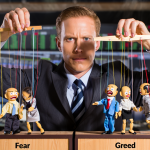
Behavioral Economics: How Psychology Fuels Investor Stupidity
Oct 22, 2024
Introduction:
Imagine you’re at a high-stakes poker table, surrounded by seasoned players. The pot has grown to a staggering sum, and you’re holding what you believe is a winning hand. Your heart races, your palms sweat, and a voice in your head screams, “All in!” But wait—is that voice your rational mind, or is it the siren call of cognitive bias, luring you towards financial ruin?
Welcome to the world of behavioural economics, where the house always wins—and the house is your psychology.
In 2008, a curious phenomenon unfolded as the global financial markets teetered on the brink of collapse. While millions of investors fled the market in panic, a select few—armed with little more than iron nerves and a contrarian mindset—made fortunes. Warren Buffett famously penned an op-ed in The New York Times, declaring, “I’ve been buying American stocks.” His rationale? “Be fearful when others are greedy, and be greedy when others are fearful.”
But what separates the Warren Buffetts of the world from the average investor who succumbs to panic selling or irrational exuberance? The answer lies not in traditional economics but in the fascinating intersection of psychology and finance.
Consider this startling statistic: According to a study by Dalbar Inc., over a 20-year period ending in 2015, the average equity mutual fund investor underperformed the S&P 500 by a staggering 3.52% annually. In other words, the very humans making investment decisions consistently lag behind a passive index that tracks the market.
Why? Because we’re not the rational actors that classical economic theory assumes us to be. We’re emotional, biased, and all too human—and these very qualities often lead us to make monumentally stupid financial decisions.
In this exploration of behavioural economics, we’ll peel back the layers of the human psyche to understand how our cognitive quirks and emotional responses shape the ebb and flow of financial markets. We’ll examine how fear and greed drive market cycles, why the illusion of control leads to overtrading, and how the wisdom of contrarian thinking can lead to outsized returns.
The Siren Song of the Herd
Imagine, for a moment, the dot-com bubble of the late 1990s. Companies with little more than a “.com” suffix to their name saw their stock prices soar to dizzying heights, defying all conventional valuation metrics. Fearing they might miss out on the next big thing, investors poured money into these speculative ventures with reckless abandon. When the bubble finally burst in 2000, it wiped out trillions of dollars in market value and left countless investors shell-shocked.
This scenario illustrates a fundamental principle of behavioural finance: the power of herd mentality. As social creatures, humans are hardwired to follow the crowd. This instinct, which served our ancestors well in avoiding predators, can lead us astray in the complex world of modern finance.
Dr Robert Cialdini, a renowned expert in the psychology of influence, explains: “We view a behaviour as correct in a given situation to the degree that we see others performing it.” This principle of social proof can create a dangerous feedback loop in financial markets, where rising prices attract more buyers, pushing prices even higher and drawing in yet more investors – until the bubble inevitably bursts.
The Pendulum of Fear and Greed
At the heart of market irrationality lies a perpetual struggle between two primal emotions: fear and greed. These twin forces drive the pendulum of investor sentiment, swinging from euphoria to despair and back again with alarming regularity.
To understand how these emotions play out in the real world, let’s dissect a typical market cycle:
- Accumulation: Savvy investors begin buying when prices are low and sentiment is negative.
- Mark-up: As prices rise, more investors notice, and optimism grows.
- Distribution: Smart money begins to sell, taking profits as euphoria sets in.
- Mark-down: Panic selling ensues as prices fall, often overshooting fair value.
This cycle repeats endlessly, driven by the ebb and flow of human emotions. The challenge for investors is to recognize where we are in the cycle and act accordingly – a task easier said than done when caught up in the heat of the moment.
The Illusion of Control
One of the most pervasive and dangerous cognitive biases in investing is the illusion of control. This is the tendency to overestimate one’s ability to influence outcomes, even when chance plays a significant role.
Daniel Kahneman, Nobel laureate and pioneer in behavioural economics, explains: “The illusion of control is fostered by a tendency to underestimate the role of chance in human affairs.” In the context of investing, this can lead to overconfidence in one’s ability to pick winning stocks or time the market—activities that even professional fund managers struggle to do consistently.
This illusion of control often manifests in the form of active trading. Studies have shown that individual investors who trade frequently tend to underperform the market, largely due to transaction costs and ill-timed trades. Yet, the allure of being in control proves irresistible to many, leading to a cycle of overtrading and underperformance.
The Wisdom of the Contrarian
“Be fearful when others are greedy, and greedy when others are fearful.” – Warren Buffett
This famous quote encapsulates the essence of contrarian investing – the art of going against the crowd. While it may seem counterintuitive, some of the most successful investors in history have made their fortunes by zigging when others zagged.
Take, for example, the financial crisis of 2008. As panic gripped the markets and stocks plummeted, most investors fled for the exits. However, those who dared to buy during this period of extreme pessimism were richly rewarded in the following years.
The Power of Patience
Contrarian investing requires courage and patience. As John Maynard Keynes famously quipped, “The market can remain irrational longer than you can remain solvent.” This highlights the importance of timing in investment decisions.
Technical analysis can be a valuable tool, helping investors identify potential turning points in market sentiment. Indicators such as the Relative Strength Index (RSI) or the MACD (Moving Average Convergence Divergence) can provide insights into whether a market is overbought or oversold, potentially signalling opportune moments to buy or sell.
However, it’s crucial to remember that no indicator is infallible. The true art lies in combining technical analysis with a deep understanding of market psychology and fundamental valuation.
The Pitfalls of Prediction
“It’s tough to make predictions, especially about the future.” – Yogi Berra
While this quip from the legendary baseball player might elicit a chuckle, it speaks to a profound truth in investing: the future is inherently uncertain. Yet, humans have an insatiable desire to predict the unpredictable, often to their detriment.
The Anchoring Effect
One of the most common psychological traps in investing is the anchoring effect. This is the tendency to rely too heavily on the first piece of information encountered when making decisions. In investing, this often manifests as an attachment to past prices or performance.
For instance, an investor who bought a stock at $100 might be reluctant to sell it at $80, even if the company’s fundamentals have deteriorated. The original purchase price is an anchor, clouding judgment and potentially leading to larger losses.
The Narrative Fallacy
Another cognitive pitfall is what Nassim Nicholas Taleb, author of “The Black Swan,” calls the narrative fallacy. This is our tendency to create stories to explain complex phenomena, often oversimplifying and ignoring the role of chance.
Investing can lead to post-hoc rationalizations of market movements or creating compelling but ultimately flawed investment theses. As Taleb warns, “The narrative fallacy addresses our limited ability to look at sequences of facts without weaving an explanation into them, or, equivalently, forcing a logical link, an arrow of relationship upon them.”
The Path to Enlightened Investing
So, how can investors hope to navigate this psychological minefield? The answer lies not in trying to eliminate our biases – for they are an intrinsic part of human nature – but in recognizing and accounting for them in our decision-making process.
Embracing Uncertainty
The first step is to embrace uncertainty. As Howard Marks, co-founder of Oaktree Capital Management, puts it: “We have to practice defensive investing since many of the outcomes are likely to go against us. It’s more important to ensure survival under negative outcomes than to guarantee maximum returns under favourable ones.”
This means diversifying investments, maintaining a margin of safety, and being prepared for a range of potential outcomes rather than betting everything on a single prediction.
Cultivating Emotional Intelligence
Successful investing requires not just intellectual prowess but emotional intelligence. This means developing the ability to recognize and manage one’s own emotions and to understand and influence the feelings of others.
Daniel Goleman, psychologist and author of Emotional Intelligence, argues that EQ is often more important than IQ in determining success. In the world of investing, this translates to the ability to remain calm in the face of market turbulence, resist the siren song of euphoria during bull markets, and find the courage to buy when others are panicking.
The Value of Process Over Outcome
Finally, focusing on the investment process rather than short-term outcomes is crucial. As Annie Duke, former professional poker player and author of “Thinking in Bets,” explains: “Resulting – evaluating the quality of a decision based on its outcome – is a common cognitive bias that can lead to poor decision-making.”
Investing means developing a robust, repeatable process for evaluating and sticking to investments, regardless of short-term market movements. It means understanding that even the best process will sometimes lead to losses and that a poor process can occasionally result in gains – but over the long run, a sound process will yield superior results.
Conclusion: The Never-Ending Journey
As explored throughout this essay, investing is as much about psychology as it is about finance. The quirks and biases of the human mind shape market movements in profound and often unexpected ways, creating both pitfalls and opportunities for the astute investor.
By understanding the psychological forces at play – from the herd mentality that drives bubbles and crashes to the cognitive biases that cloud our judgment – we can hope to navigate the financial markets with greater clarity and confidence. But make no mistake: this is not a journey with a final destination but an ongoing learning, adaptation, and self-reflection process.
As we strive to become more rational investors, we must also recognize the inherent irrationality of the markets in which we operate. In this tension – between our quest for logic and the often illogical behaviour of the crowd – the true art of investing lies.
So, as you venture forth into the turbulent waters of the financial markets, armed with the insights of behavioural economics, remember the words of Benjamin Graham, the father of value investing: “The investor’s chief problem – and even his worst enemy – is likely to be himself.” By turning the lens of scrutiny inward and cultivating a deep understanding of both market psychology and our emotional responses, we can hope to transcend the common pitfalls of investor stupidity and chart a course towards long-term success.










